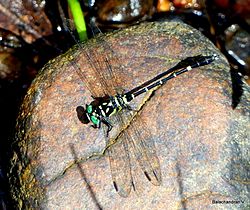Microgomphus souteri
| Microgomphus souteri | |
|---|---|

| |
| Male | |
| Scientific classification | |
| : | [[Template:Taxonomy/Microgomphus]] |
| Species: | Template:Taxonomy/MicrogomphusM. souteri
|
| Binomial name | |
| Template:Taxonomy/MicrogomphusMicrogomphus souteri Fraser, 1924
| |
Microgomphus souteri[2] is a species of small dragonfly in the family Gomphidae. It is endemic to the forest streams of Western Ghats of India.[1][3]
Description and habitat[edit | edit source]
It is a small dragonfly with bottle-green eyes. Its thorax is black with slightly interrupted mesothoracic collar and narrow ante-humeral stripes. There is a broad black stripe on postero-lateral suture. Abdomen is black, marked with greenish yellow. Segment 1 has a narrow apical border. Segment 2 has a broad basal ring. Segments 3 to 6 have narrow basal rings. Segment 7 is similar, but broader. Segments 8 to 10 are unmarked. Female is similar to the male.[4]
It looks similar to Microgomphus torquatus; but can be distinguished by the marks on thorax and by the shape of the anal appendages. Superior appendages have the inner branches much longer, springing from the appendages much nearer the base, and extending beyond their apices. The small outer spine near the apex is much more noticeable. Inferior appendage is more robust and slightly longer. It is distinguished from other similar Gomphidae by the shape of the anal appendages.[5][4][6][7][8][9]
It is commonly seen resting on stones or rocks in the stream bed.[4]
See also[edit | edit source]
References[edit | edit source]
- ↑ 1.0 1.1 Subramanian, K.A. (2011). "Microgomphus souteri". IUCN Red List of Threatened Species. 2011: e.T175173A7117241. doi:10.2305/IUCN.UK.2011-1.RLTS.T175173A7117241.en. Retrieved 20 November 2021.
- ↑ Template:World Odonata List
- ↑ K.A., Subramanian; K.G., Emiliyamma; R., Babu; C., Radhakrishnan; S.S., Talmale (2018). Atlas of Odonata (Insecta) of the Western Ghats, India. Zoological Survey of India. pp. 239–240. ISBN 9788181714954.
- ↑ 4.0 4.1 4.2 C FC Lt. Fraser (1934). The Fauna of British India, including Ceylon and Burma, Odonata Vol. II. Red Lion Court, Fleet Street, London: Taylor and Francis. pp. 355–356.
- ↑ "Microgomphus souteri Fraser, 1924". India Biodiversity Portal. Retrieved 2017-02-11.
- ↑ C FC Lt. Fraser (1924). A Survey of the Odonate (Dragonfly) Fauna of Western India and Descriptions of Thirty New Species (PDF). pp. 471–474.
- ↑ Halali, Sridhar; Halali, Dhiraj; Rangnekar, Parag (2015). "Range extension of Microgomphus souteri Fraser, 1924 (Insecta: Odonata: Gomphidae) to northern Western Ghats, India". Journal of Threatened Taxa. 7 (8): 5887–5893. doi:10.11609/JoTT.o4259.7480-3.
- ↑ K.G., Emiliyamma; Muhamed Jafer, Palot; C., Radhakrishnan (2012). "Microgomphus souteri Fraser, a new addition to the Odonata (Insecta) fauna of Kerala, southern India" (PDF). Journal of Threatened Taxa. 4 (6): 2667–2669. doi:10.11609/JoTT.o2885.2667-9.
- ↑ "Microgomphus souteri Fraser, 1924". Odonata of India, v. 1.00. Indian Foundation for Butterflies. Retrieved 2017-02-11.
